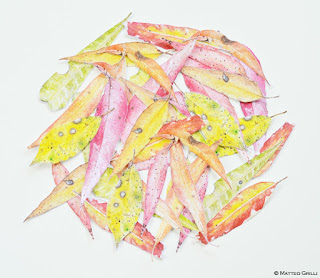This is the first painting from a series all dedicated to the Jabiru or Black-necked Stork, Ephippiorhynchus asiaticus. I found its regal posture, slow movements and secretive attitude very charming.
New items in store:
 | ||
| Set of four printed greeting cards featuring a selection of some favourite Aussie iconic birds: Pale-headed rosellas, Crimson Rosellas and Kookaburras. Size of each card: 14 x 14 cm or 5.5 x 5.5'' Buy Now |
 |
| Australian Nature Treasures, set of five square greeting cards. Size of each card: 14 x 14 cm or 5.5 x 5.5'' Buy Now |
 | ||
| Imagine a walk in the Australian bush just after rain, there are many
wet leaves scattered along the path and many of them have very
attractive bright colours. Imagine the intense yet delicate smell of the
Eucalyptus trees spreading all around, and the sound of your footsteps. Take a little bit of that unique, simple beauty into your home with this set of forty loose printed leaves of Australian plants, Eucalyptus tree mostly. Each leaf has been cut out from a digital print on paper of my original realistic watercolor illustration. You can use this special collection to give you home a taste of the charming Australian bush, following are some suggestions on how to use them, please feel free to contact me to share your ideas! - You can decide to display them under the glass top of a table. - You can arrange them in a display cabinet. - You can mount them on a support and frame some of them and use the rest for something else, remember, they're forty. - You can use them as bookmarks. Colors may vary from real (they're actually much better). Buy Now |






Beautiful portrait! I love the female's yellow eye.
ReplyDeleteYou've got the colours and the posture so beautifully.
Also, I didn't know it was called Jabiru! How interesting! Thanks for this post.
Una maravilla de trabajos con una técnica muy personal por tu parte.
ReplyDeleteEnhorabuena por tus pinturas.
Saludos.
Wonderful!
ReplyDeleteThank you very much Gowri, Javier and Sharon :)
ReplyDeletebellissimo, regale, ma é lo stesso che c'é in sudamerica?
ReplyDeleteGrazie Patrizia, questa e' la specie australiana/asiatica.
ReplyDelete